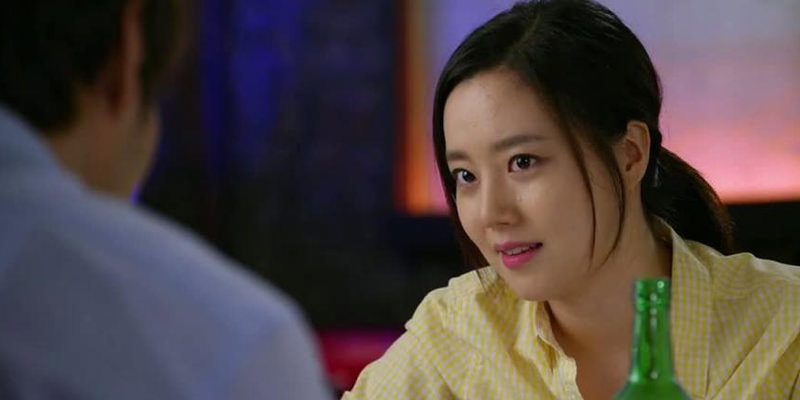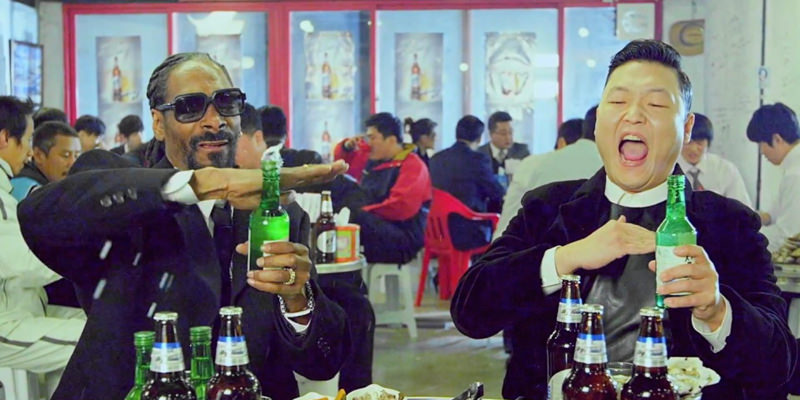Like a plasticized, electronic armada, Korean pop culture is invading the world. “Hallyu,” meaning K-pop, K-film, K-TV and K-video games, is taking over screens from China to Malaysia, India to Iran, Peru to California. And Korea’s iconic alcoholic beverage – soju – is invading along with it, being fired like artillery shells into the breach.
Daniel Gray, director of Delectable Travels, a food tour company in Seoul, says he sees it all the time. Foreign tourists in Seoul “have seen [soju] on dramas, on the music videos and everything,” Gray says. “They know it goes well with certain food. My tour guests that come here, they do that sound” – Gray imitates an old Korean man clearing his throat after a shot of soju. “They’re imitating art and doing it in real life.”
Soju is the world’s best-selling spirit. According to the trade publication Drinks International, over 73 million cases of Jinro soju were sold last year. Chumchurum, the second biggest soju brand, was third in the world, selling 31 million cases (See maps and charts of the 2014 rankings here). Granted, the majority of that soju is drunk in South Korea, but not all of it.
The rise of soju is as unlikely as the rise of the country it comes from. South Korea went from being one of the poorest countries in the world in the 1950’s – decimated by war, famine and foreign occupation – to the fourth richest country in Asia and a powerhouse export economy.
The drink that fuels the Korean worker who achieved such economic miracles is soju. Soju is similar to a half-proof vodka – the alcohol content per volume ranges from 21 to 16 percent, depending on the brand – and it’s almost universally acknowledged to taste awful. Though there are a few premium brands out there, when it comes to the vast majority of soju consumed, nobody takes a sip of it, swishes it around, and declares, “Yes, this brand has hints of tropical fruit, a slight pepperiness, and tinges of vanilla at the finish.”
No, it all tastes like gasoline and people drink it because it’s $1.25 a bottle and they want to get drunk. No one even knows what it’s distilled from, whether it’s potatoes, sweet potatoes, or rice – when you ask most Koreans, they’ll simply say “chemicals,” and urge you not to drink it on an empty stomach. Many Koreans are completely amazed that any foreigner can drink it at all, and urban legends about foreigners dying from overconsumption of soju are rife in the country.
Given all this, why would anyone outside of South Korea drink it?
Part of it has to do with soju’s low alcohol content compared to other spirits.
In California, soju has benefited from an exemption under state licensing laws. Focusing on its low alcohol per volume, Korean businesses successfully lobbied to have it sold at restaurants with beer and wine only licenses. Drop two shots in instead of one, mix it up with orange juice, and you’ve got a basic screwdriver, but without having to pay $12,000 for a full bar license. More elaborate cocktails are put together at restaurants and bars throughout the state.
But it’s Korea’s cultural capital that is really selling the stuff. Psy, of “Gangnam Style” fame, declared soju to be “his best friend” and has become the face for Chamisul, a Jinro sub-brand, the world over.
Psy is just the tip of the iceberg when it comes to Korean pop culture exports. In fact, he’s something of an outsider, given that most K-pop stars are young, trim, beautiful, and thrashed within an inch of their lives in how to dance, sing, smile, strip, speak, and act, by the huge corporate overlords that create almost all of Korea’s pop music. Psy, meanwhile, is older, rotund, less conventionally handsome, has expressed political convictions, and though he’s most famous for his signature horsey-dance, I don’t think anyone would describe it as particularly professional or well-choreographed.
Two more conventional ambassadors for K-pop are Big Bang and Girls’ Generation, a five-person boy band and eight-person girl band respectively, which were produced by Y.G. and S.M. Entertainment, two huge companies that specialize in churning out bubble-gum pop stars.
In a write-up in Canada’s Financial Post, Melissa Leong described how successful K-pop has become. “In 2011, Billboard announced its K-pop Hot 100 Chart,” she writes. “K-pop stars including Girls’ Generation, 2NE1 and Big Bang play sold-out concerts around the globe including in the U.K. and U.S. The artists mix English, Japanese and Mandarin into their songs purposefully as a way to connect to international fans.”
But it’s the K-dramas, or Korean soaps, that are really getting the soju flowing. “Everyone wants to go to a tent restaurant and drink soju and eat chicken feet,” says Gray, discussing his Asian clients. They see it on the TV shows and they can’t wait to try it for themselves.
According to Oh Ingyu, a professor at Korea University and an expert on Hallyu, it was Korean dramas that started the phenomenon in the early 2000’s, mostly by their appeal to middle-aged Japanese women, who watched the shows and started to “love Korean culture.”
“And that had a widespread, rippling effect,” Oh says. Japanese women thought Korean cultural content was appealing from a women’s point of view. “It was a pro-woman kind of content. The main characters are mostly women, and they succeed despite their problems. They overcome despite male pressures, male chauvinism, and so on. So in the end, the women triumph. And that gave a sense of liberation and emancipation to Japanese women.”
From there it went to China, Southeast Asia, the Middle East, Europe, and the Americas. Oh says it’s the focus on women that is driving it, and indeed, most Hallyu fans do appear to be women. “It’s the only woman-centred content in the 21st century all over the world,” Oh says. “If you look at Hollywood, you rarely see women-oriented content. You mainly see male hero oriented movies and content.”
Others see brilliant marketing on the part of the South Korean government and others. Oh denies that the government is responsible, but Euny Hong, author of The Birth of Korean Cool, says it’s because of government efforts that it’s been so successful.
“The Korean government spent tax money translating these videos into other languages; they approached television networks and asked, ‘Will you air this?’” Hong said in an interview with the Financial Post. “That’s not something a capitalist country does. Obama does not send someone to go to other countries to ask them to buy ‘Law and Order’ episodes.” (Hong was unavailable to speak with VinePair.)
Hong describes the spread of Korean culture around the world as a “full-on amphibious attack,” according to The Economist. Government sponsorship matched a conservative and largely innovation-less economic model that, ironically, produces just what a lot of people want: mass-produced entertainment that is easy to swallow, and isn’t produced by China or Japan, both of whom have negative images as aggressors in the region.
“Korean dramas are so popular in the Philippines that they have inspired local remakes in Tagalog,” says The Economist. “‘[Soap opera] Winter Sonata’ […] was a hit in Iraq and Uzbekistan. Japan is now using the Korean model as inspiration: in what is perhaps the best evidence of its own waning power as a trendsetter, it has launched a $500m fund to invest in ‘Cool Japan’.”

All in all, the Korean cultural industry represented $5 billion in global revenue in 2013, according to The Economist. The government hopes to double that by next year.
So where does this leave our turpentine-flavored friend? Well, in Islamic K-drama hotbeds Iran, Indonesia, Iraq, and Egypt, not very far, though perhaps Korean soda-makers will have more luck there. But in the rest of the Brave New K-World, fans are imitating the stars, and forcing down the soju.
Soju is widely and cheaply available in Chinese and Japanese groceries, and in most of America, especially the aforementioned California. In Southeast Asia it’s being transformed into all sorts of exotic cocktails, especially with yogurt.
“We meet a lot of Southeast Asian tourists that come, and they know about yogurt soju before I can even tell them about it,” Gray says.
Plus, fans want to imitate the party end of it – soju drinkers do seem to have a very good time on TV. “As far as Korean drinking culture goes, the social aspect of drinking here is a big draw for people around the world,” Gray says. “Back home we often drink alone, but here you have everyone enjoying themselves around a bottle. It’s very social. And the [entertainment] media shows that very well.”
Whether there’s much of a future for soju is unclear. Drinking it straight is only palatable if it’s cheap, and alcohol taxes and duties mean that it’s impossible to price it abroad as cheaply as it’s priced in Korea.
Hamish Smith, the deputy editor at Drinks International, told NPR that he thinks it’s unlikely soju will ever take over, mostly because vodka filled that role in the 1950’s, to become America’s top-selling clear spirit.
It will also depend on Korean culture continuing its full-frontal assault on world taste. The Korean government, and Koreans generally, would like to see Soul become the new Hollywood, but most people think that’s unrealistic. According to a survey reported in the Korea Times, most Hallyu fans themselves “expect Korea culture will subside in the next four years.”
But then, that survey was done three years ago – and the Halllyu Army marches on.



